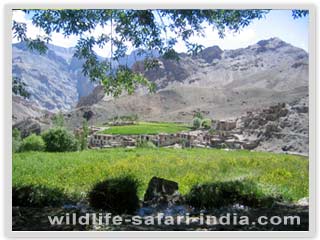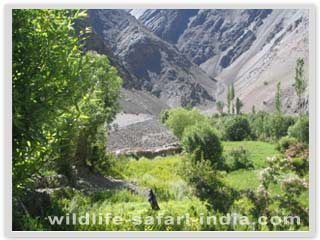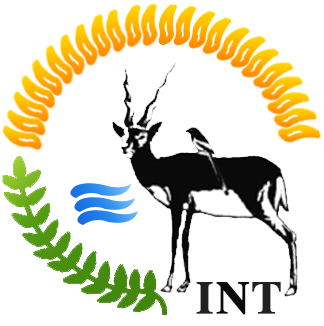
Ecotourism
HOME-STAYS:

Himalayan wilderness
You stay in local village homes situated in remote Himalayan wilderness close
to protected areas and nature reserves. Your hosts are the local inhabitants,
with their unobtrusive gracious hospitality and first-hand experiences of how
they peacefully co-exist with wildlife in the present environment. This community
based tourism initiative gives you a memorable, insightful and cost-effective
experience and also generates direct benefits for the local communities, helping
them protect their cultural and natural heritage for future generations.
Villages settled close to national parks and reserves suffer unavoidable income
losses from livestock depredation and agricultural losses due to wild herbivores
and predators. Home-stays are a good way to offset this loss and generate additional
income for locals. Through their participation we help create sustainable economic
alternatives as opposed to natural resource exploitation and retributive killings.
The local people also serve as guides and take you on wildlife viewing and village
walks. You stay in clean comfortable but simple dwellings with solar or candle
light. Traditional meals are cooked hygienically by eco-friendly methods, with
training imparted by organizations like Mountain Institute, Wildlife Institute
of India and Snow Leopard Conservancy.

Ladakh
Locations:
Ladakh - In Ladakh's Hemis High Altitude
National Park you stay in pastoral villages like Rubak, Kaya, Sku, Shingo, Urutse
and Chilling. Hemis is India's best-protected area for Snow Leopards and a stay
involves trekking through scenic Himalayan terrain. Your hosts are the local
Buddhists and you get to experience their simple way of life.
Sikkim - Nestled between North-East India and
Nepal, our home-stays in Dzongu district of Sikkim offer a peek into the area's
rich endemic flora and fauna. Hosted by the local Lepcha tribes, you stay in
the vicinity of the Kangchendzonga Biosphere Reserve, which offers panoramic
views of Mt Kangchendzonga, the third highest peak in the world.
Uttaranchal - Located on the periphery of the
Corbett Tiger Reserve, our home-stay at Bhakrakot is surrounded by tropical
broadleaf forest and is very rich in game density. You can also stay around
Binsar Wildlife Sanctuary as both these areas offer a truly wild experience
full of alarm calls, evidence of big cat scat and pugmarks. Your hosts are the
extremely warm mountain people, the Kumaonis and Garhwalis.
Coorg - In Coorg, South India's region known
for its fragile ecological biodiversity, we offer farm-stays inside rainforests.
You stay inside plantations where crops like cardamom, coffee, pepper and vanilla
are grown organically under the shade of rainforest trees. You have a choice
between premium organic farms like Mojo Rainforest Retreat and Golden Mist Plantations
or earthy farm-stays around Brahmagiri Wildlife Sanctuary, Nagarahole National
Park and Thadiyendamol, the highest peak in Coorg.
Biodiversity Conservation Trust of India (Bcti)
The Biodiversity Conservation Trust of India OR
BCTI was founded in July 2002 as a public charitable Trust and registered under
the Indian Trust Act, 1882.
It has following objectives -
To promote the ecological security of society.
To provide for secular management of the country's precious biodiversity.
To strive for protection of the environment.
To assist forest dependent communities to co-exist.
Biodiversity Conservation Trust of India has been actively involved in the Kuno
Wildlife Sanctuary of M.P. that is proposed second home for the Asiatic lions
since its formation.
At present, Gir National Park and Sanctuary in Gujrat is the Asiatic lion's
last resort in the world. A small population of the big cats represents
an extremely restricted population distribution; this leaves them vulnerable
to variety of extinction threats like epidemic, diseases and other natural calamities.
With a view to prevent the extinction of the Asiaticlions, the Wildlife Institute
of India conducted a survey in search of a new home for the big cat. The Kuno
wildlife Sanctuary in the northwest Madhya Pradesh was finally selected as the
site to establish a second free ranging population of this mega carnivore.
BCTI initiated its work in association with the forest department at and around
the Kuno wildlife Sanctuary. BCTI has been involved with the rehabilitation
of 24 villages from within the Sanctuary to create a human free environment
for the lions.
BCTI Activities
1. Regular interaction with the villagers:
The BCTI has been interacting with the rehabilitated villages as well as surrounding
villages of the Sanctuary on the regular basis for information decimation on
various issues ranging from agriculture, drinking water and watershed development
and management. Special attention are being given on agriculture in which rehabilitated
villagers are being informed on the importance of crop selection, weed removal
seed selection etc.
2.Technical support:
BCTI has been giving technical support to the different developmental activities
initiated by the forest department at the rehabilitation site as well as in
the peripheral villages.
3.Wildlife Week:
The lion reintroduction program is in progress with the rehabilitation of all
the 24 villages from within the Kuno Wildlife Sanctuary (KWS). The forest department
has been doing everything with their small staff base. Therefore, Biodiversity
Conservation Trust of India extended its support to the Forest Department for
the mass awareness program during the wildlife week. It is being done in the
first week of October every year in the surrounding areas keeping students,
teachers, village panchayat heads and elders and the government officials as
a target group. Slide shows, films, painting and quiz competitions are organized
on wildlife conservation theme.
4. Training on Joint Forest management:
Conducted workshop/training program for the frontline staff and Chairperson,
Secretary and members of Forest Protection Committee & Village Forest Committee
of Kuno wildlife Division and Sheopur Forest Division. This was organized every
month for 7-8 days from October 2002 to January2003 in association with the
forest department. Aim of the training was to involve villagers into forest
conservation, which in turns bring them benefits.
Wildlife Mass Awareness Campaign
A systematic awareness campaign was also initiated to prepare neighborhood communities
to live with a mega carnivore like lion- an animal that they never encountered
before. This campaign was initiated at various places from March-April 2003
in association with the Sanctuary management and the Biodiversity Conservation
Trust of India (BCTI) in which information on the lion reintroduction program
has been given. Exclusive slide shows were given at various places during this
campaign in which stress has been given to reduce the number of cattle. It was
tried to convince the community with the help of slides that a healthy population
of big cats in the neighboring forest helps community with the increased water
level in their wells as well as increased soil moisture content in their agricultural
fields.
5. Preparing Microplan:
BCTI is presently involved in the micoplan preparation of the rehabilitated
as well as adjoining villages in association with the forest department.
The microplan would act as a blue print of the village development. It would
help the implementing agencies in finding out developmental initiatives at the
village level according to the priority fixed by the villagers through micoplans
BCTI intended to work in the buffer areas including rehabilitation site on cattle
management issues, which would ultimately reduce the grazing pressure on the
sanctuary and other eco-development aspect.




